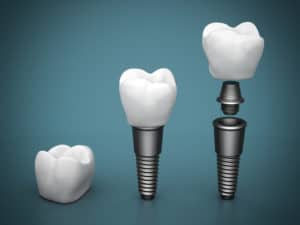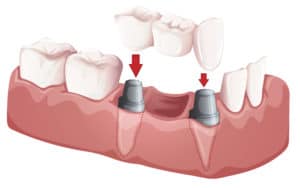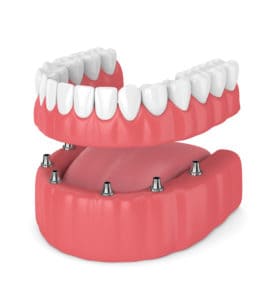Dental implants are one of the biggest advances in dentistry over the past 40 years. While dental implants are commonly used to restore smiles, offering patients the ability to regain their self-confidence, many people don’t realize that dental implants come in a variety of styles, sizes, and placements, to meet each patient’s individual need.
Types of implants

While traditional dentures are used to replace one or more teeth through the use of a single dental implant, your options for restoring your smile go beyond that. With even bigger advancements in dentistry, patients now have choices like mini dental implants, implant supported dentures and fixed partial denture implants. By learning more about the different dental implant options available to you, you’ll feel confident in your dental implant choice, and can spend the rest of your life showing off your beautiful smile to the world.
Single and two-stage dental implant

While all dental implants are placed within the mouth in a similar manner, their size and area of implantation make them effective for different implant procedures. Regardless of the dental implant option you choose, in most cases, either single, Endosteal or two-stage implants are used to secure the implants abutment or implant device. While single and two-stage implants are similar, there’s a few key differences that make these processes unique.
- Single implants: Single implants are generally completed during one appointment. Prior to the implant procedure, your dental professional will meet with you, do x-rays, discuss your options with you, and then create a treatment plan. Once you’re ready for the implants, you’ll undergo a surgical procedure, and the implants (longer in size than the other 2 traditional implants) are placed within the jawbone, with the top of the implant aligned with your gum tissue. The gum tissue is then closed with stitches, but the implant is exposed, which allows the area to heal for several months. The implant abutment (tooth colored fixture) can be attached to the implant upon healing due to the exposure stitch method used, without the need for further surgery to access the implant head.
- Two-stage implant: The process of installing a two-stage implant is almost identical to a single implant, except the manner in which they are closed. While a single implant is stitched open, allowing the implant to be exposed, the two-stage dental implant is stitched over the entire implant for healing. Once the area is healed completely, a minor surgery is needed to remove the gum that’s covering the implant, which will allow the implant abutment to attach to the implant.
- Endoseal implant: These are the most commonly used dental implants. They are placed in the jawbone and often used during a two-stage dental implant procedure. These implants are commonly used in procedures where implants are used for devices that are alternative to traditional bridges and removable dentures.
- Mini implant: Mini dental implants are a lot like their name. They are mini versions of dental implants, and their size allows many people who are not candidates for traditional implants, to have them done. They are generally not used for full mouth implants, but as supportive implants for procedures designed to hold bridges, fixed dentures, or similar devices in place. They are also screwed into the jaw, but they are much less invasive than the traditional sized implant.
Implant procedures

While traditional dentures are used to replace one or more teeth through the use of a single dental implant, your options for restoring your smile go beyond that, including options like implant supported bridges, implant supported dentures, and fixed partial implants. By learning more about the different dental implant options available to you, you’ll feel confident in your dental implant choice, and can move ahead knowing that your smile will look great upon completion of the implant process.
- Implant supported bridge: A dental bridge is supported by two teeth, and the middle tooth within the bridge is a fake tooth that works to fill in the space between two teeth. Natural teeth are often used as part of the bridge, where they are capped with two crowns to better support the false tooth that fills the empty space. In some cases, a patient may be missing several teeth in one area, and there aren’t any adjacent teeth to hold the bridge in place. In this type of situation, an implant can be used to support the bridge at one time. Implant supported bridges are either three or four part bridges, and they can replace up to three teeth at a time.
- Fixed dentures: Dentures have been used to replace missing teeth for as long as tooth replacement dentistry has been around. While they do work to help a patient maintain their chewing ability, there’s several setbacks that a patient can experience with this type of replacement for their natural teeth. Removable dentures are only held in place by suction, and many patients experience what’s known as floating dentures, especially lower dentures. When dentures become loose, it often affects a person’s self-confidence and they tend to avoid many of their favorite foods, in fear of their dentures slipping. Luckily, implants are now used to hold dentures in place, and you only need a few to hold an entire arch of fake teeth. Generally 3-5 implants are placed on the upper or lower area of the patient’s mouth, and the denture will either clip to the denture, and be removable by the patient or will be secured in place by the implants and can only be removed by a dental professional. Both detachable and permanently secured dentures offer patients the ability to chew, talk, and smile with confidence and eliminates the need for dozens of implants. Patients who are not candidates for traditional implants may be able to use mini implants to secure their denture in place.
- Partial implants: A dental partial is used to replace one or several missing teeth. Unlike a denture that replaces every missing tooth, a partial can be used when a patient has one or more teeth missing, and as the teeth are removed in the future, additional teeth can be added to the denture. A standard partial hooks onto other teeth in the mouth, which can lead to damage of the teeth and the device isn’t always sturdy. Dental implants can be used as an alternative method to keep a dental partial in place. Generally 2-3 implants are placed in the upper or lower jaw, and the implants will clip to the partial denture, creating a secure fit. Implants eliminate the need for the partial to clip to other teeth, the need for metal clasps, and many patients find they feel much more confident with this type of denture.
Conclusion
There are many options when it comes to using dental implants, and it’s easy to feel overwhelmed by the many options presented to you. However, working with a professional dentist, who specializes in dental implants, is the best way to ensure you choose the right type and the procedure goes flawlessly. Your dentist can offer you additional information about the different dental implant methods, and help you choose one that will help you feel confident with the look and function of your smile.
